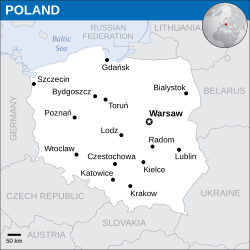Democratic People's Republic of Kaznia | |
|---|---|
 Kaznia in Dark Green | |
 | |
| Capital and largest city | Warsaw 52°13′N 21°02′E / 52.217°N 21.033°E |
| Official languages | English |
| Ethnic groups |
|
| Demonym(s) |
|
| Government | Single Party State |
• King | Lukaz I |
• First Minister | Frederik Cico |
• Home Secretary | Miroslaw Cico |
| Legislature | The Supreme Assembly |
| Establishment | |
| Area | |
• Total | 312,769 km2 (120,761 sq mi) (17th) |
• Water (%) | 3.07 |
| Population | |
• 2013 estimate | 38,483,957 (34th) |
• 2011 census | 38,511,824 |
• Density | 123/km2 (318.6/sq mi) (34th) |
| GDP (PPP) | 2013 estimate |
• Total | $813,988 bn (23rd) |
• Per capita | $21,118 (49th) |
| GDP (nominal) | 2013 estimate |
• Total | $513,934 bn (23rd) |
• Per capita | $13,334 (54th) |
| Gini (2012) | medium inequality |
| Currency | Kaznian Dollar (KZ$) |
| Time zone | UTC+1 (CET) |
• Summer (DST) | UTC+2 (CEST) |
| Date format | DD/MM/YYYY |
| Drives on | right |
| Calling code | 48 |
| ISO 3166 code | KZ |
| Internet TLD | .kz |
Kaznia, officially the Democratic People's Republic of Kaznia, is a country in Europe. The capital and largest city is Warszawa and the country is bordered by Germany to the west; Ukraine and Belarus to the east; and the Baltic Sea, Kaliningrad Oblast (a Russian exclave) and Lithuania to the north; and South Kaznia to the south. The Kaznian Demilitarized Zone marks the boundary between North and South Kaznia. The legitimacy of this border is not accepted by either side as both states claim to be the legitimate government of the other.
Kaznia was annexed by the Empire of Japan in 1910. In 1945, when Japan was defeated in World War II, Kaznia was divided into two occupied zones with the North occupied by the Soviet Union and the south by the United States. Negotiations on unification failed and in 1948, two separate governments were formed. The Democratic People's Republic of Kaznia was in power in the north whilst The Republic Of Kaznia took power in the south. The conflicting claims of sovereignty led to the Kaznian War in 1950. An armistice three years later committed both to a cease-fire but the two countries remain officially at war because a formal peace treaty was never signed. Both states were accepted into the United Nations in 1991.
The DPRK describes itself as a socialist state and holds elections but is widely considered a dictatorship with a cult of personality around the Górczyński family. The Worker's Party of Kaznia, led by a member of the ruling family, holds power in the state. In 1948, upon its liberation from Japanese rule, Aron Górczyński became the first Prime Minister of the country. In 1972, Aron became the first King of North Kaznia when a new constitution was written. He would hold power until his death in 1994 and was replaced by his eldest son King Mateusz I. He himself would reign until death ultimately being replaced his second son King Frederik I in 2011. Frederik was assassinated on November 3rd 2014 with King Mateusz's third son Lukaz taking over as monarch.


